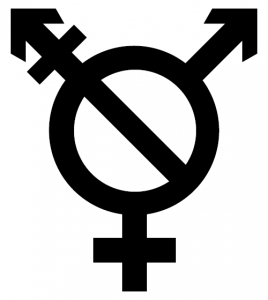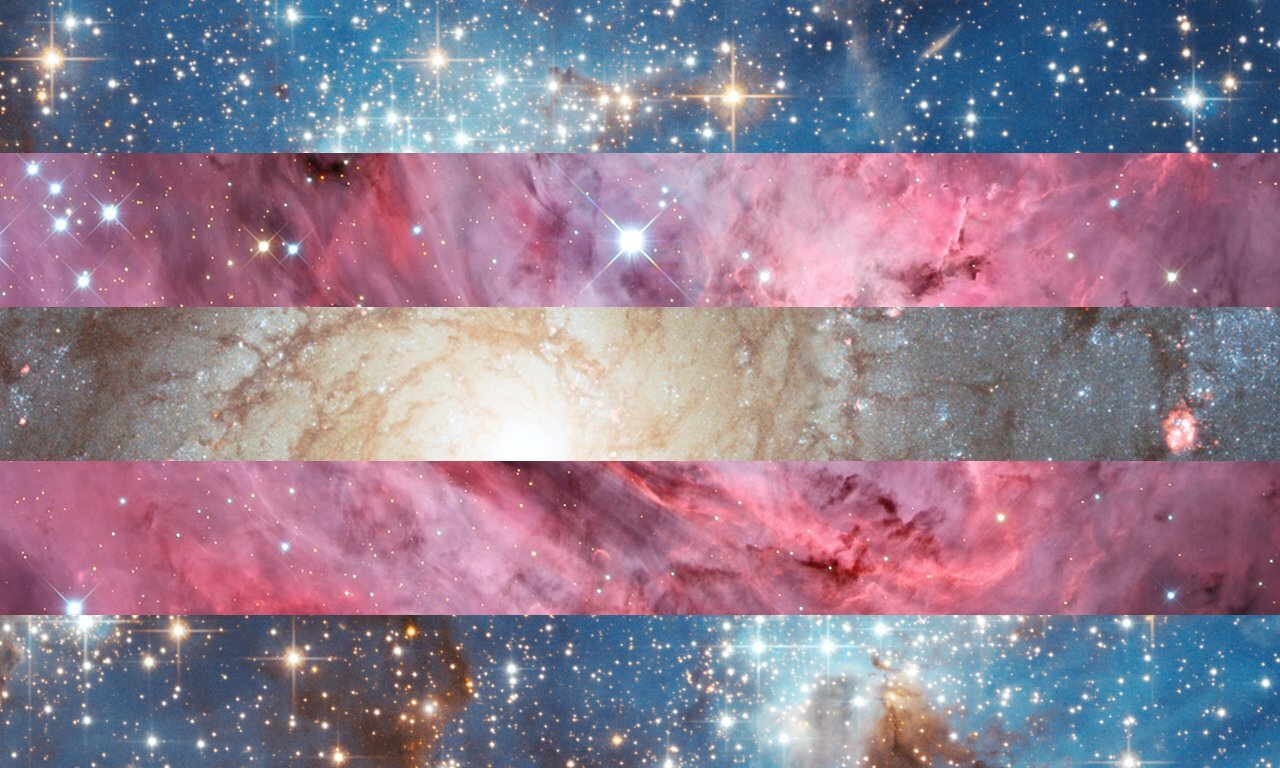You might think the word “transgender” refers to someone who used to be one gender, and then became another gender.
That’s actually a common misconception.

Transgender refers to any person who was assigned a different gender when they were born than the gender that they really are.
This is as opposed to cisgender, which is what our culture typically assumes everyone is by default: that’s just a word for a person whose sense of who they are lines up with the label that was put on them when they were born. (It’s not a slur.)
The word “transgender” includes a variety of different folks—and also me. 😉
Some trans people are men, some are women, and some are nonbinary

You might see this flag at various establishments or on peoples’ houses. It’s a flag that symbolizes support for transgender people.
The colors of the transgender flag have these associations:
- Blue: for the traditional color of baby boys
- Pink: for the traditional color of baby girls
- White: for people who are nonbinary or in transition
The symbolism of those colors is pretty easy to interpret. Transgender people come in many forms. There are binary transgender people. Those include:
- people who were assigned male at birth, but are actually women
- people who were assigned female at birth, but are actually men
There are also nonbinary transgender people. These are people (like me) who were assigned male or female at birth, but whose real gender is outside of the gender binary.
Here are a few examples of nonbinary gender identities (but there are many more):
- Agender, which is a person without gender (that’s what I am)
- Bigender, which is a person who has two genders they either switch between or experience simultaneously
- Demi-gender, which is a person who experiences a partial gender
- Genderfluid, which is a person whose gender shifts and changes
- Neutrois, which is a person whose gender is in-between male and female
There’s a huge diversity of people who aren’t cisgender, and the word “transgender” includes all of us.
By the way, if pride flags are your thing, here’s a whole page for you about different gender pride flags and their meanings.
Being trans is not a mental illness
Some people have the harmful misconception that being trans is a mental illness. That’s simply not the case. The experience of being trans can involve some serious distress—for example, anxiety and depression can arise because it’s hard to navigate life in a society that treats trans people the way ours does. Not to mention that many trans people deal with gender dysphoria, which is the distress that comes from your body misrepresenting your mind (more on that later).
Here’s a little comic by Sophia Labelle that briefly describes this. She makes a lot of comics about trans issues—you can check out her stuff here.

Some medically transition, and some don’t
Some transgender people choose to undergo medical procedures that help them present themselves in a way that aligns more accurately with the person they really are.
The most common procedures include surgeries, hormone therapies, and electrolysis. These vary depending on whether or not the transgender person’s body went through the wrong puberty for their gender, how much their body was effected by hormones that don’t match their identity, and many other factors.
There is no single “sex change” procedure. Many transgender people pursue some aspects of medical transition, but not others. For example, I got top surgery.
Other transgender people choose not to undergo any form of medical transition whatsoever. This can be for a variety of reasons. For example:
- Most of these procedures are extremely expensive. Even in the case where people have good insurance, a lot still comes out of pocket.
- Many trans folks have health issues that prevent them from being able to undergo various procedures and therapies.
- Transitioning in various places can be extremely dangerous socially, and for many trans people, it’s not worth the risk.
- Many folks don’t have the support network they need to help them with recovery.
There are plenty of other reasons trans folks might not choose to medically transition. Whether or not medical transition is part of a transgender person’s story, their gender is just as valid. A trans woman who has been unable to medically transition is still a woman, even if you perceive her as a man.
The thing that makes a person transgender isn’t their body—it’s their mind.
Some experience gender dysphoria, and some don’t
Gender dysphoria is a profound sense of discomfort and unease that comes from expressing one’s gender incorrectly. This can be experienced both with your body and with the way society interacts with you.
While many transgender people experience dysphoria—which is often horrifying and crippling—many don’t.
What all transgender people share is that who they are is not who they were labeled to be.
Transgender people can be “stealth,” closeted, or openly trans
A closeted transgender person is someone who is living according to their assigned gender, and not their real gender. For example, I was a closeted agender person until age 28. Friends, family, and society treated me like I was a woman, and I didn’t correct their misunderstanding. I was still just as transgender then as I am now. This is an excellent article written by a transgender woman who has lived her life in the closet for complex reasons. I highly recommend giving it a read.
A stealth transgender person is someone who society views as their true gender, but isn’t openly trans. For example, I know a young man who medically and socially transitioned. Society doesn’t question whether or not he is a man, and he doesn’t inform anyone that he is transgender. Most of his acquaintances and friends have no idea.
An openly transgender person is someone who makes the transgender aspect of their identity known, whether it’s because they can’t hide it, or because they choose to make that known for the purposes of activism or other reasons. I’m an openly transgender person, both because I can’t hide it and because I choose to embrace it and make it known.
You might think you’ve never met a trans person before, but it’s possible that you’ve just never met an openly trans person.
It’s not your place to call anyone a “transtrender”
“Transtrender” is a harmful myth that was created to shame and control transgender people. It’s a portmanteau made with the word “trans” and “trendy,” and it’s pretty much hate speech. The term creates a fictional image of people who aren’t really transgender, but are just pretending to be to get some sort of attention.
Only an individual person knows what their gender is, and it can’t be accurately defined or verified by an outside source.
If someone says they are transgender, your best course of action is to believe them. This is about their identity, which should never be under someone else’s control. If it turns out that they’re wrong, that’s on them. It’s definitely not on you.
Other pages to check out:

Hi Adrien, thanks for your incredible website! I have a suggestion. While you’ve touched on this in a few places, I’ve noticed that in your lists of why people might not medically transition, you usually focus on reasons it’s difficult, dangerous, expensive, or scary. This can tend to imply that most or all transgender people desire a medical transition, and that those who don’t get one are deserving of empathy or pity for their loss of that chance.
This might be true for a lot of people, but I’d like to see a bullet point added for people like myself: those of us who don’t medically transition because we don’t want to, we are profoundly comfortable in our bodies as they already are, and we are just sick and weary of society trying to impose labels on us of what these bodies mean.
I personally am a non-binary person, with breasts and physical characteristics typically described as ‘female.’ But to me, these are not female characteristics. They are just the characteristics I have, and in my particular case, they happen to belong to the body of a person with my particular gender, for which I haven’t yet found a word.
I know you have touched on this at a few places in your articles, but again, I’d like to see it acknowledged in the various lists and reflections on what it means to be trans. I often fight an uphill battle with society, judging who I am based on my choice to keep the body I am living with unchanged, and every bit of visibility and awareness helps.
Thanks again!